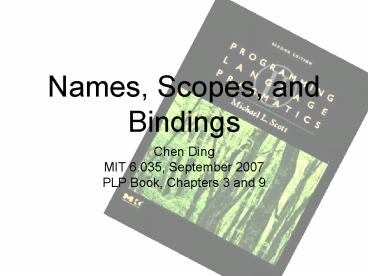Names, Scopes, and Bindings - PowerPoint PPT Presentation
1 / 16
Title:
Names, Scopes, and Bindings
Description:
Stack and Heap. Stack-based allocation. frame or activation record ... heap management. garbage collection. Static Scope. Single, global scope. early Basic ... – PowerPoint PPT presentation
Number of Views:37
Avg rating:3.0/5.0
Title: Names, Scopes, and Bindings
1
Names, Scopes, and Bindings
- Chen Ding
- MIT 6.035, September 2007
- PLP Book, Chapters 3 and 9
2
High-level Names
- Assembly level
- memory address and memory content
- Language and program level
- variables
- types
- procedures
3
Binding Time
- Language design time
- primitive types, control flows
- Language implementation time
- machine dependent parameters
- Programming time
- user defined functions and data
- Compile time
- the layout of statically defined data
- Link time
- intermodule references
- Load time
- physical memory allocation
4
Object lifetime
- The life of an object
- creation of the object
- creation of the binding
- references
- deactivation and activation
- destruction of bindings
- destruction of objects
5
Allocation Types
- Static
- fixed size, live throughout the execution
- global variables, strings, tables for debugging,
run-time type checking, exception handling, etc - often read-only
6
Stack and Heap
- Stack-based allocation
- frame or activation record
- parameters, local vars, temporaries
- Heap-based allocation
- dynamically sized objects
- heap management
- garbage collection
7
Static Scope
- Single, global scope
- early Basic
- common blocks in Fortran
- Nested subroutines
- Algol style closest nested scope rule
- check the innermost scope and then successively
surrounding scopes
8
Pascal Example
- procedure P1(A ...)
- var X real
- procedure P2(B ...)
- var X integer
- ...
- procedure P3(C ...)
- ....
9
Modules
- Info. hiding through explicit import/export
- fewer name conflicts, more robust system and
better error reporting - A module is a collection of objects
- objects inside are visible inside but not visible
outside unless exported - Clusters in Clu, Modula, packages in Ada,
namespaces in C
10
Module-as-Type
- Object-oriented programming
- a class can be viewed as a module augmented with
inheritance - encapsulation
- the this pointer
- my_stack.push(x), instead of
- push(my_stack, x)
- inheritance
11
Dynamic Scope
- int a
- void first() a1
- void second() int a first()
- void test()
- a 2
- if (b) seond()
- else first()
- print(a)
12
Reference Environment
- First-class values
- can be passed as a parameter, returned from a
subroutine, or assigned into a variable - subroutines in functional languages
- Second-class values
- can be passed as a parameter
- subroutines in imperative languages
- Third-class values
- e.g. labels
13
Dynamic Binding
- Alias
- common blocks, equivalence statements
- pass-by-reference in C
- Overloading
- subroutine names, operators
- false polymorphism
- Polymorphism
- same name, different actions
- generic routines
14
Example Polymorphism
- class Animal void MakeNoise() ...
- class Dog inherits Animal void MakeNoise()..
- class Cat inherits Animal void MakeNoise()...
- void Sing(Animal a) a.MakeNoise()
15
Implementing Scope
- Symbol tables
- name-to-object bindings
- variables and types (classes)
- forward references
- The scope stack
- search down from top to bottom
16
Summary
- Binding times
- Allocation schemes
- Modules and classes
- Reference environment
- Scope rules
- Dynamic binding
- Symbol tables































